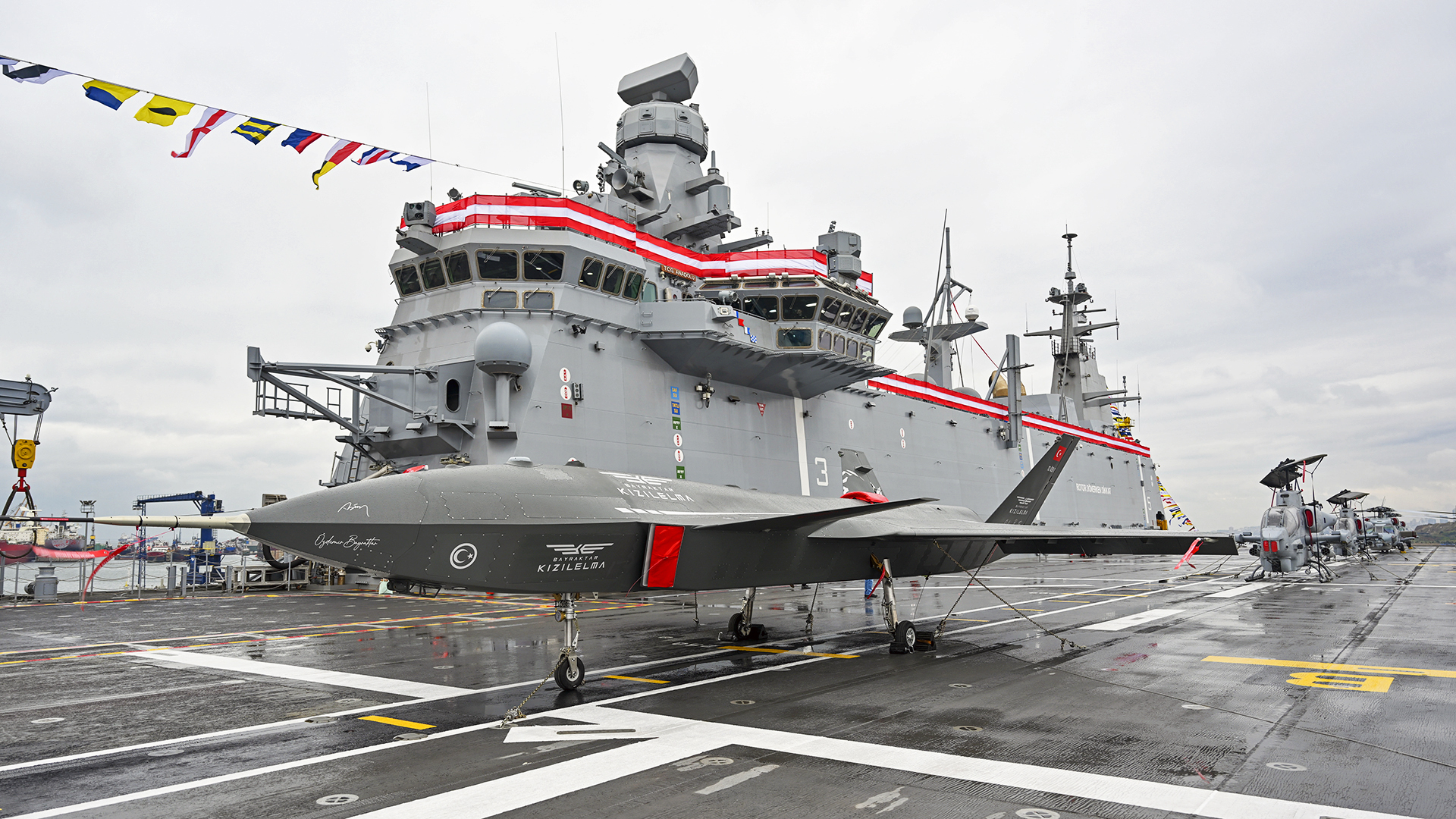The Turkish Navy on Monday celebrated the entry into service of its new flagship, the TCG Anadolu, now the country’s largest warship, with an inauguration ceremony held about three months after the ship’s actual delivery due to scheduling conflicts. The Anadolu is classed as an amphibious assault ship, but officials in Turkey say they have big plans to also use the vessel as a carrier for different tiers of armed drones.
Based on the design of Spain’s Juan Carlos I amphibious assault ship, Anadolu was laid down at the Sedef Shipyard in the city of Istanbul beginning in 2018. The vessel was launched just one year later and preliminary trials were completed in 2022. Speaking at the delivery ceremony also held at Sedef, Turkish President Recep Tayyip Erdogan noted that 70% of Anadolu was built using only parts and components made in Turkey, including its weapons, combat systems, radars, infrared search-and-track capability, and electronic warfare suite.
“This vessel will allow us to conduct military and humanitarian operations in every corner of the world when needed,” said Erdogan. “We see this vessel as a symbol that will consolidate Turkey’s regional leadership position.”
Anadolu has a typical landing helicopter dock (LHD) configuration, with a large flight deck on top and a well deck at the rear. It’s intended to project forces ashore during an amphibious assault using helicopters, landing craft, and both light and heavy armored vehicles. Erdogan went on to speak about the range of additional capabilities Anadolu could provide as well, which include command and control, medical support, and humanitarian relief.
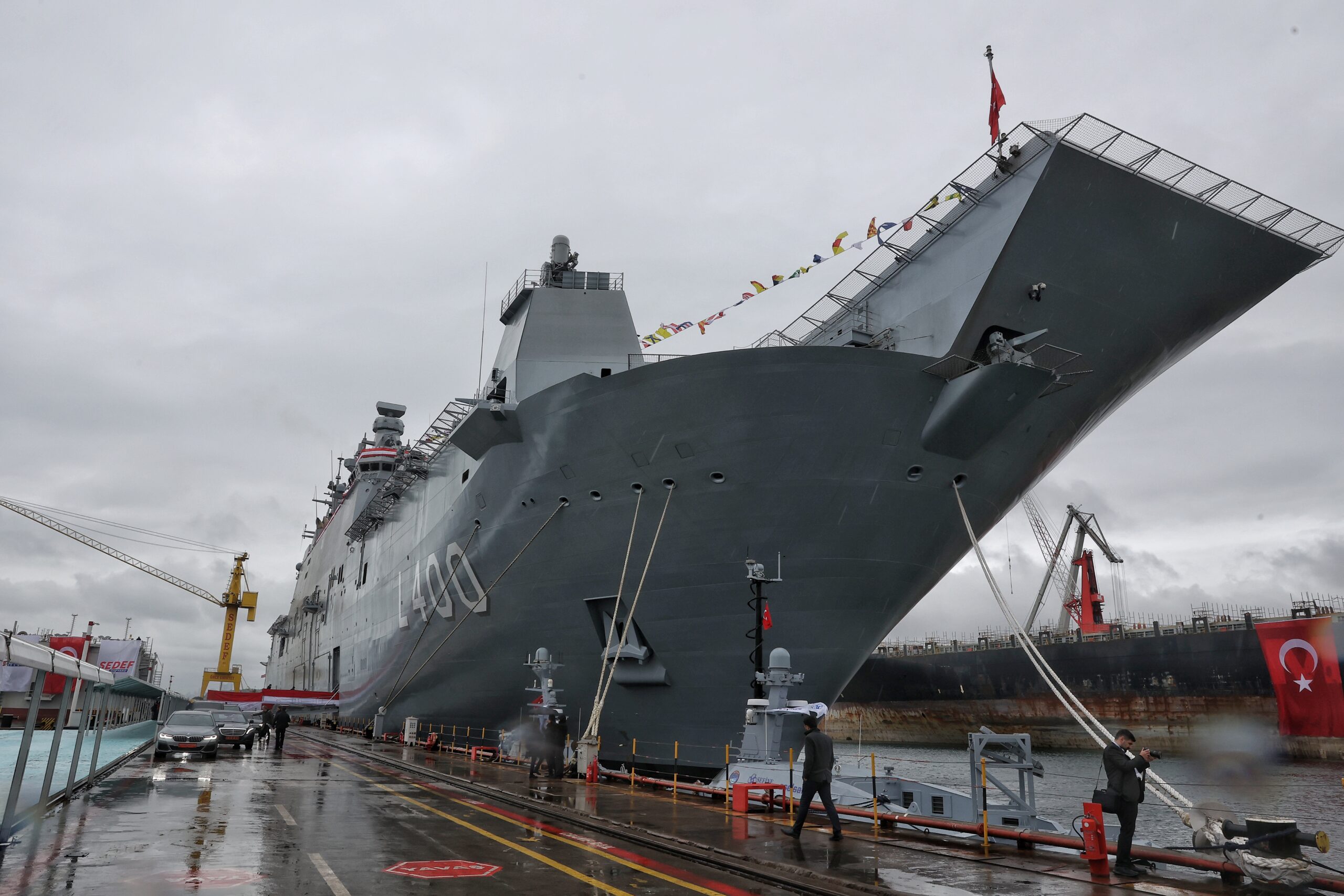
Erdogan also prominently highlighted Anadolu’s ability to carry and deploy a variety of armed drones, which is a concept that Turkey has been envisioning for the vessel for some time now. Since the ship was initially ordered back in 2015, Anadolu has evolved to become a unique multipurpose vessel that also can focus on unmanned aircraft operations. In this way, it should move beyond traditional manned rotary-wing capabilities, basically acting as a light aircraft carrier for combat drones.
A mix of all these capabilities will give the ship a lot of flexibility for its class.
In February of this year, it was reported that in order to realize the shift in Anadolu’s air wing, the vessel would undergo slight refits to its infrastructure to better support drone operations. These were to include the introduction of drone control stations with satellite terminals for longer-range connections, the installation of a ‘roller system’ at the ship’s bow to help launch the uncrewed aircraft, the addition of an arresting gear system on the deck to facilitate unmanned combat air vehicle (UCAV) landings, and safety nets for the recovery of smaller types of drones.
According to figures released by Turkey’s Ministry of National Defense, Anadolu measures 758 feet long, about 105 feet wide, and has a displacement of 27,436 tons. The vessel boasts a top speed of around 21 knots with a full load, has a range of 9,000 nautical miles, and can operate at sea for up to 90 days. A press release published by the ministry also noted that Anadolu is able to carry one battalion of 1,400 troops in addition to its crew of roughly 400 sailors.
In terms of its capacity for ground assets, the press release went on to add that “13 tanks, 27 amphibious assault vehicles, six armored personnel carriers, 33 [various light and heavy armored vehicles], [and] 15 trailers can be transported on the light and heavy vehicle deck of the ship.” Anadolu can also carry up to six landing craft of various types in its well dock, which would be critical in conveying the aforementioned ground vehicles and troops ashore.
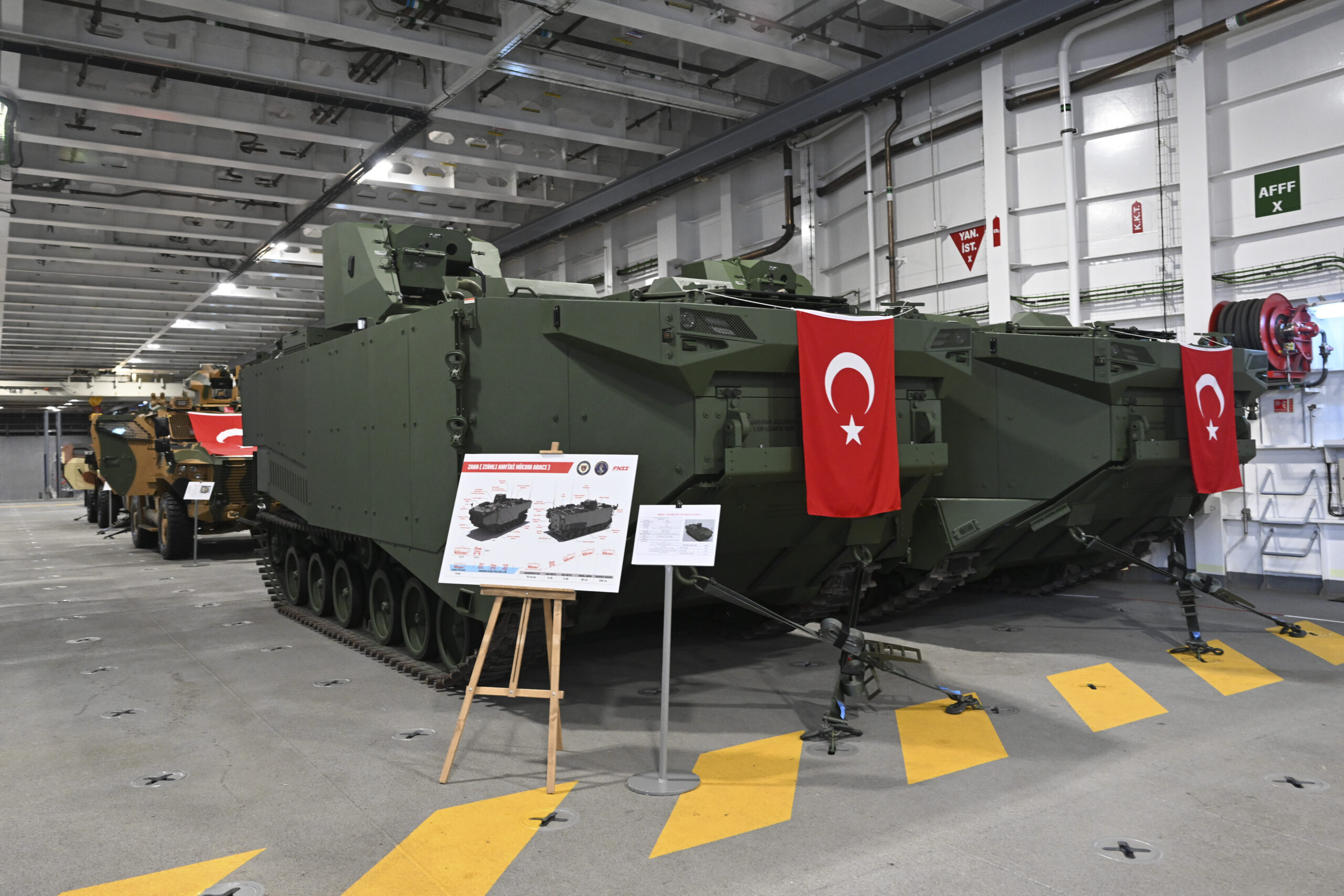
Discussions about Anadolu’s air wing have drawn the most attention. The vessel has a 58,600-square-foot flight deck in a ski-jump configuration with six landing points for medium-lift transport, assault, or general-purpose helicopters, and an additional two spots for heavier transport types, according to an article published by Daily Sabah.
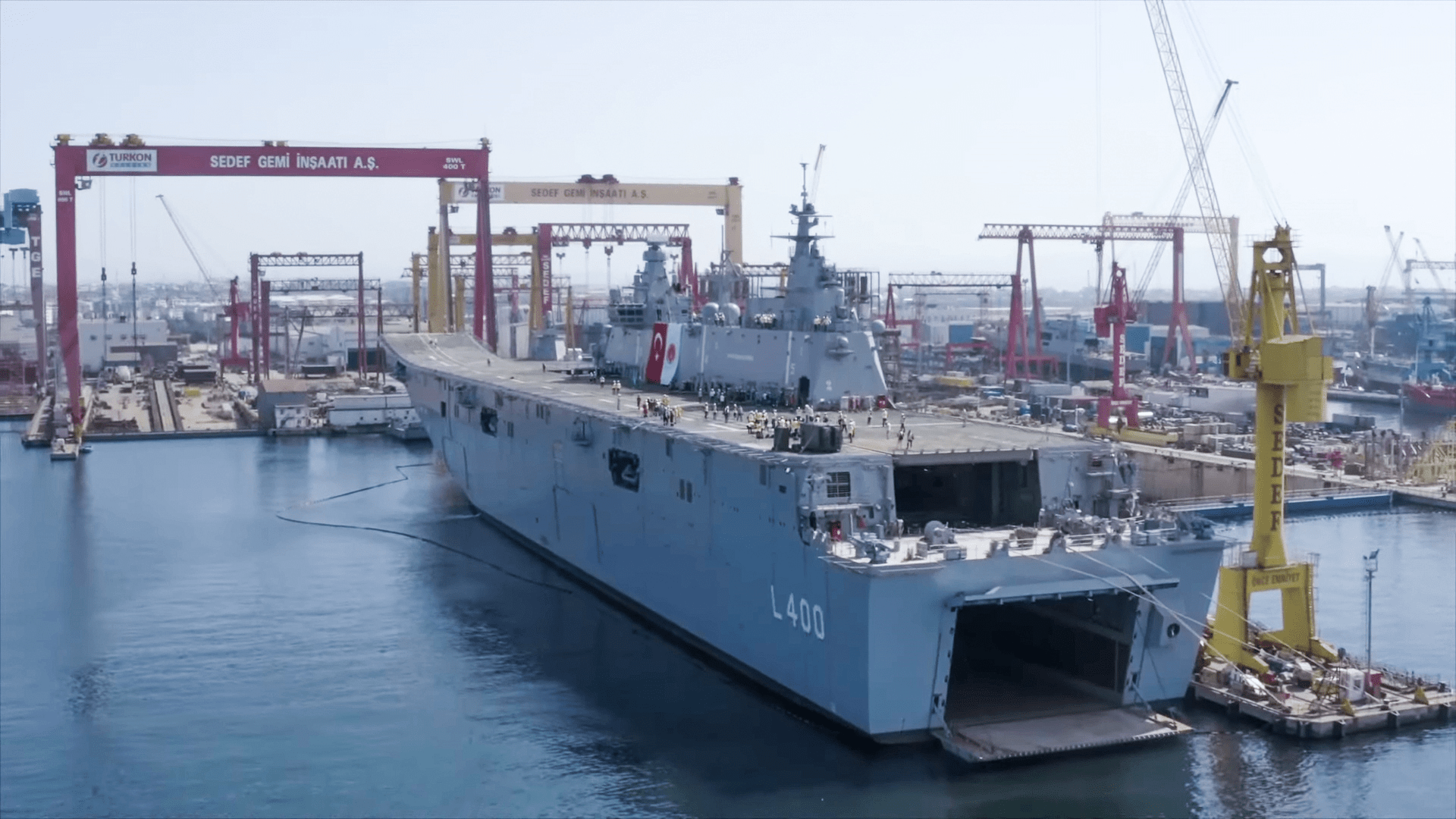
Compatible rotary-wing assets are known to include types like the T129 ATAK and the AH-1W Super Cobra attack helicopters as well as SH-60B anti-submarine warfare helicopters. AS532 Cougars, S-70/UH-60 Black Hawks, and CH-47F Chinooks could supply medium and heavy utility support. Erdogan added that the fixed-wing TAI Hürjet trainer/light fighter will be able to take off from and land on Anadolu, as well. While this has been looked into and supposedly simulated, we do not know if this is actually a real concept that the Turkish Navy is looking to pursue, as there are major training and equipment demands that go with it. It certainly is an interesting mention regardless.
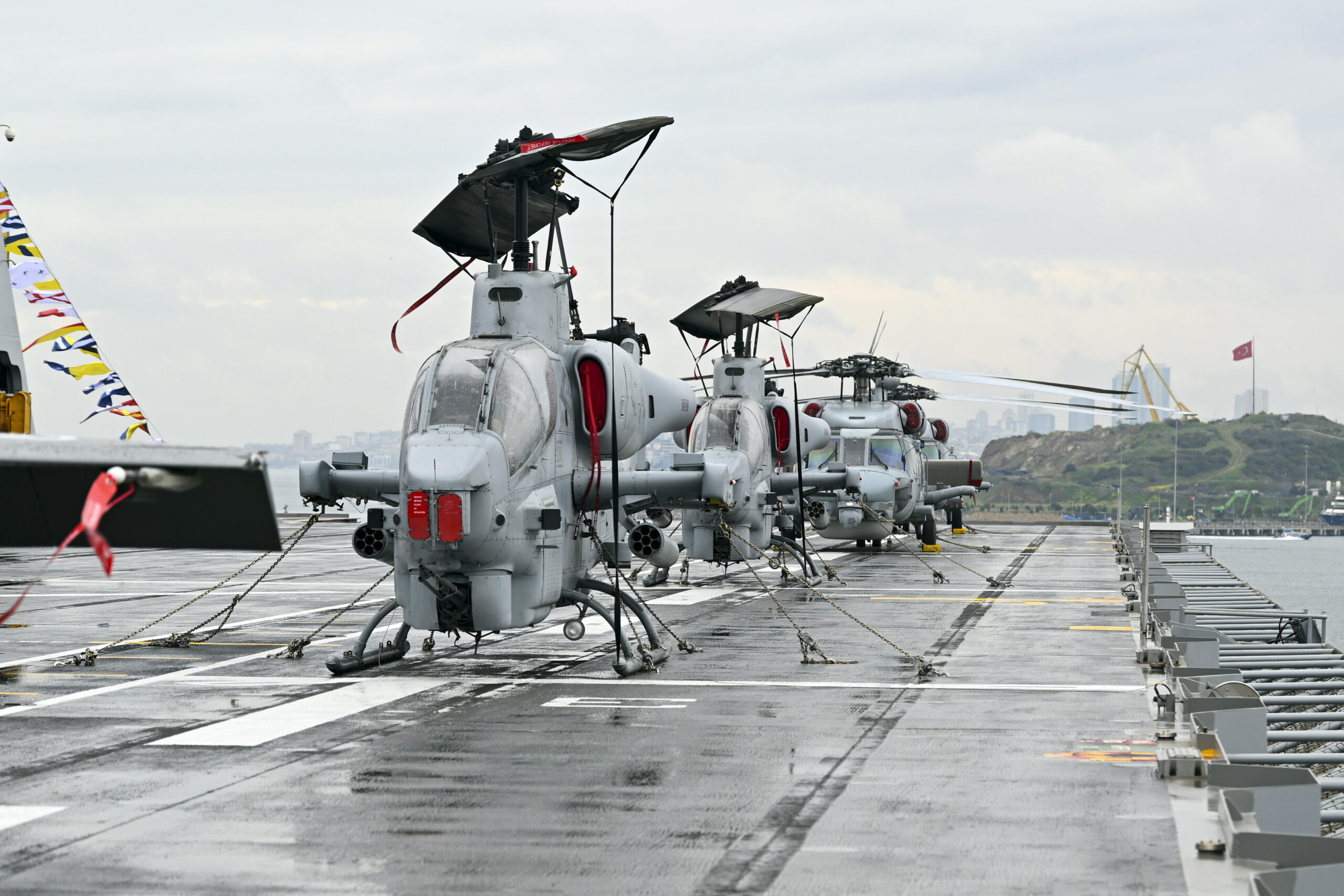
The ministry’s press release stated that Anadolu “can deploy 12 manned or unmanned combat aircraft, 21 different types of helicopters, and [UCAVs] depending on the operation to be carried out within the scope of the aircraft transport capability.”
At present, the new folding-wing Bayraktar TB3 designed by the Turkish drone-maker Baykar is expected to be Anadolu’s primary armed drone. The TB3 is a naval evolution of the company’s combat-proven TB2 drone, which has gained particular prominence throughout the ongoing conflict in Ukraine after years of increasing popularity. The TB3, however, is being designed specifically with the ability to take off and land on aircraft carriers and amphibious assault ships with short runways.
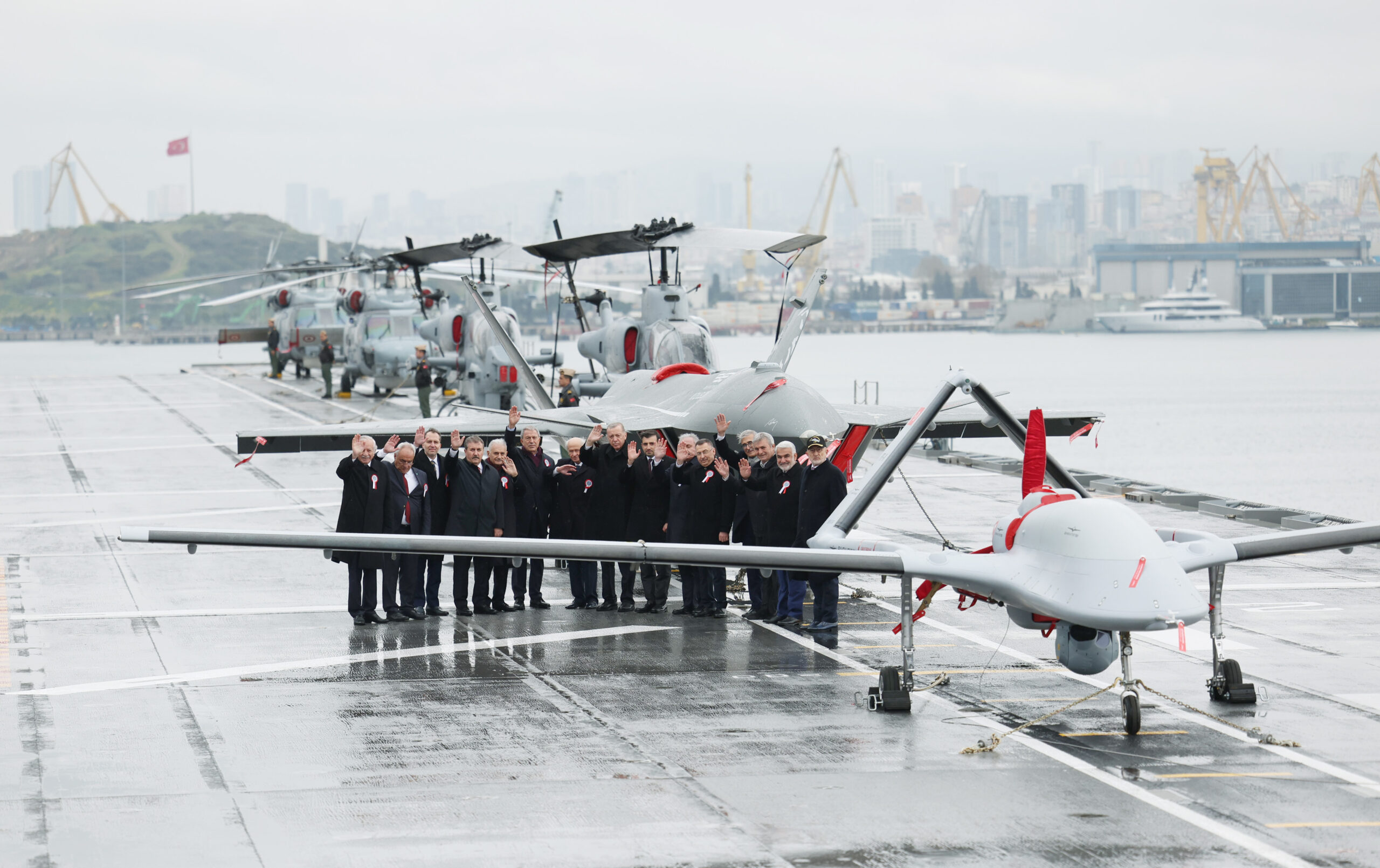
Baykar released the first images of the TB3 late this March, revealing that the drone will officially be unveiled during Turkey’s TEKNOFEST 2023 to be held at Istanbul’s Atatürk Airport between April 27 and May 1. The TB3 has yet to take to the skies in any publicized capacity, but the company has said that flight testing is set to begin sometime this year.
Baykar’s jet-powered Kizilelma drone is also intended to be a part of Anadolu’s air wing being that the aircraft is similarly designed to take off from short-runway carriers. While this type is still early in its development having first flown just last December, the company is specifically identifying it as Turkey’s first fighter UCAV.
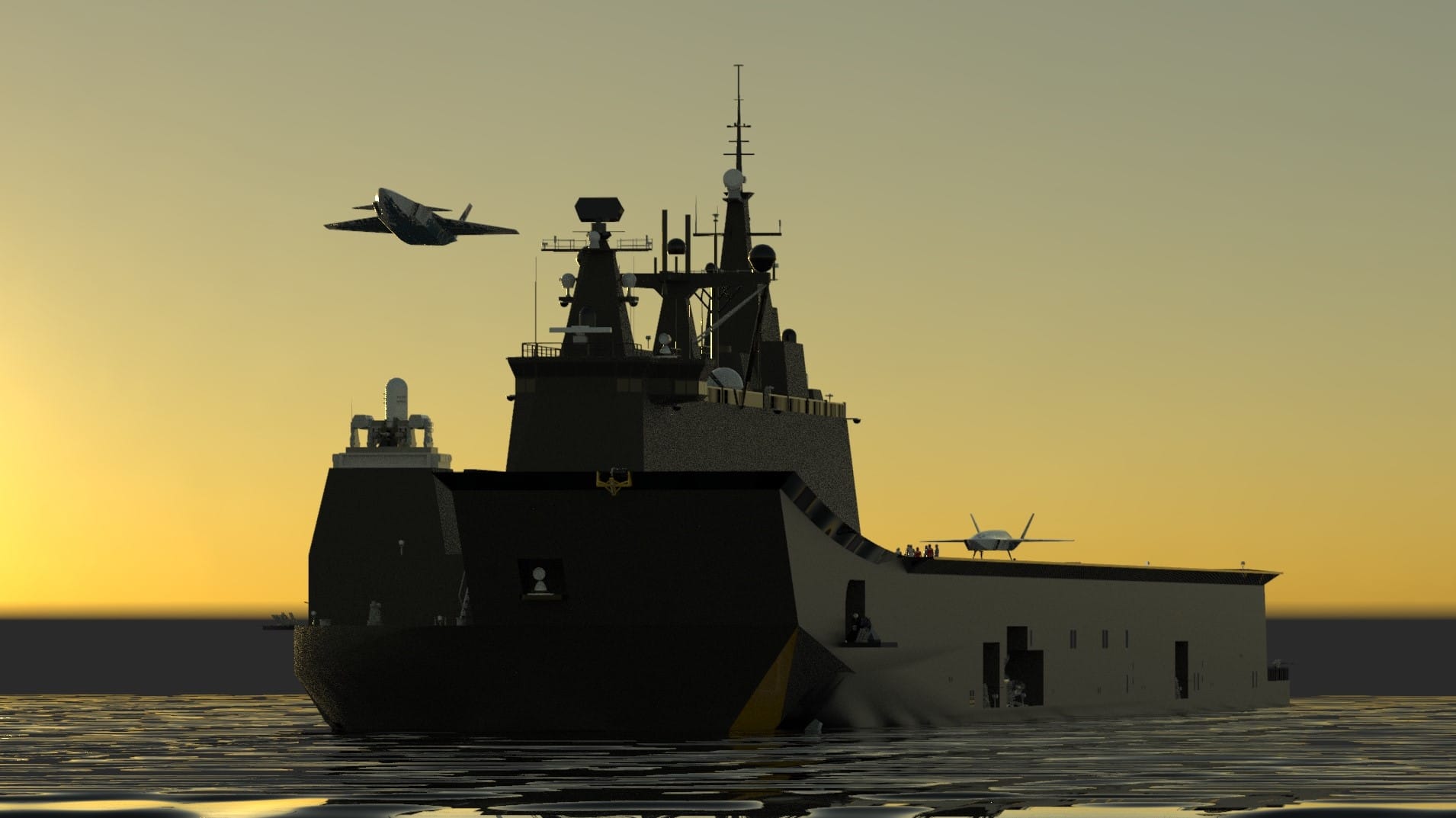
The company has stated that Kizilelma will have an endurance of five to six hours, a combat radius of 500 nautical miles, a service ceiling of 35,000 feet, and a maximum speed nearing Mach 1. Baykar has also divulged the drone’s maximum takeoff weight to be 13,228 pounds, including a payload of 3,306 pounds. Kizilelma took its first flight in December of last year.
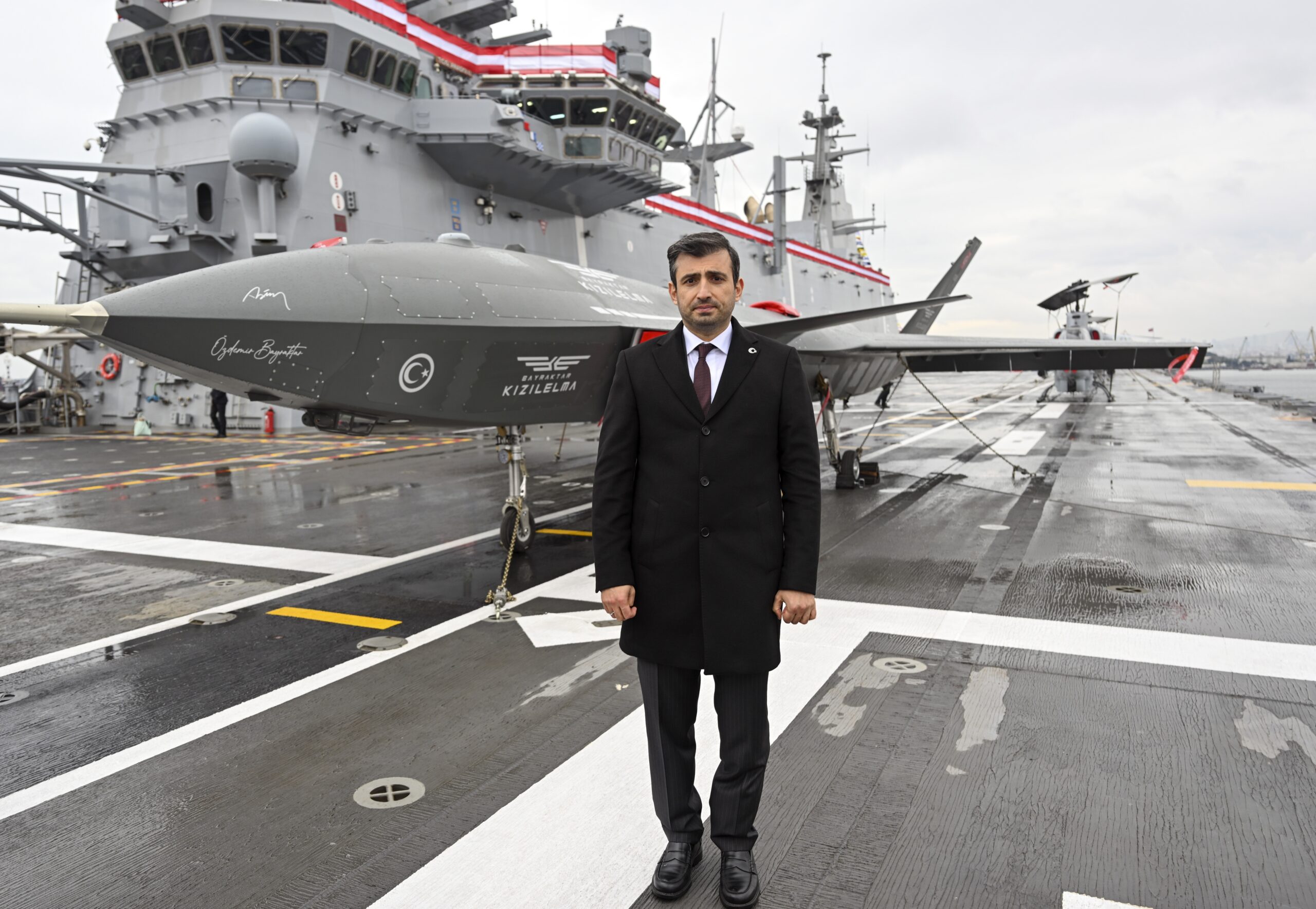
It will be interesting to see how this ship with limited deck space will operate such disparate types, including a fast jet drone that requires an arresting gear system to land and presumably the entire deck for takeoff, under real-world conditions.
Turning Anadolu into a drone mothership wasn’t always the main focus of its development, however, as F-35Bs or AV-8Bs were initially supposed to play a significant part. In 2019, the U.S. kicked Turkey out of the F-35 program in response to the latter country’s purchase of Russian S-400 air defense systems. It’s worth noting that Turkey had already invested some $1.4 billion into the F-35 program, with various Turkish companies making hundreds of parts for the stealth jet as well.
Turkey had been in discussions regarding acquiring surplus USMC Harriers, as well. But we have not heard anything about them moving forward. Aside from a possible second-hand Harrier buy, expulsion from the F-35 program left Turkey without the carrier-capable short takeoff and vertical landing (STOVL) F-35B fighter jets for its new warship. This, combined with the rapid rise of indigenous unmanned combat aircraft capabilities, prompted the country to eventually turn to its drone industry to fill the gap aboard the vessel. In doing so, these aircraft would not be beholden to U.S. or other foreign component suppliers, either.
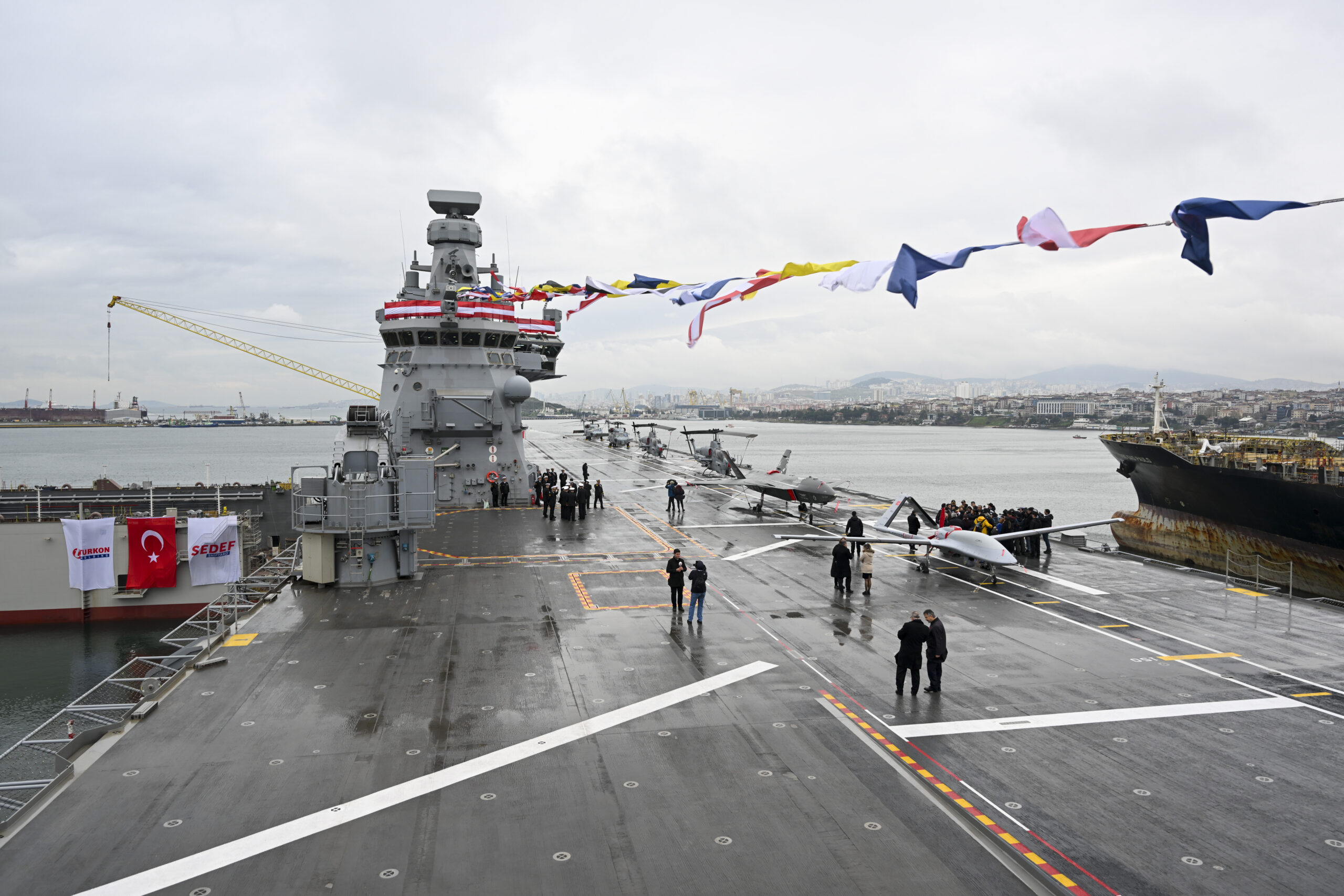
Turkey’s plans for Anadolu also underscore the country’s ambitions to grow its ability to project power regionally and even globally. Following the earthquake that devastated the country this February, the humanitarian relief capability Anadolu will provide can’t be understated, either.
Now that Anadolu has officially joined the Turkish Navy’s fleet, it will certainly be interesting to see how the warship proves its multi-role concept of operations with a very heavy reliance on multiple types of drone aircraft. As militaries across the globe increasingly move toward integrating uncrewed assets into their operations, Turkey could blaze something of a trail. Especially if it can get its fighter-like drone to operate from it while offering relevant advantages, all at a far lower cost than similar manned capabilities.
Contact the author: Emma@thewarzone.com
